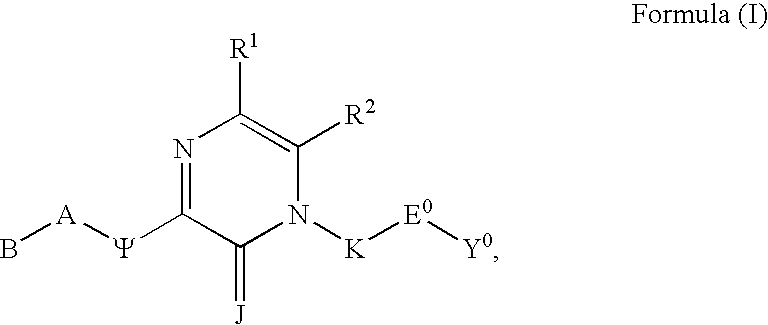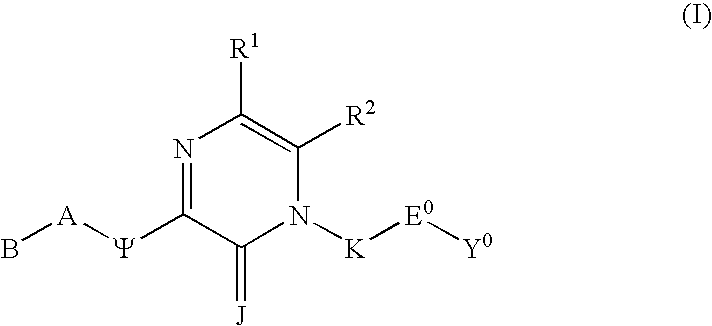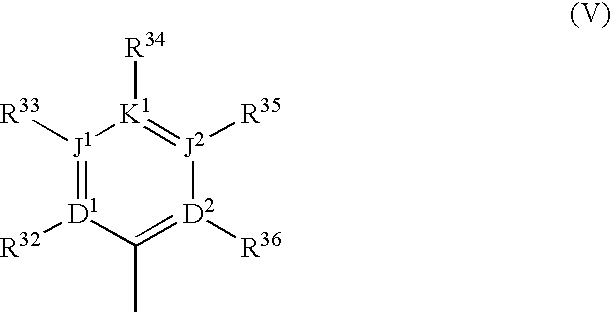Substituted polycyclic aryl and heteroaryl pyrazinones useful for selective inhibition of the coagulation cascade
- Summary
- Abstract
- Description
- Claims
- Application Information
AI Technical Summary
Benefits of technology
Problems solved by technology
Method used
Image
Examples
example 1
[0630]
[0631]A solution of benzyl glycine hydrochloride (78.00 g, 386.8 mmol) in 1.2 L ethyl acetate was washed with brine and saturated Na2CO3 (1:1, 3×1 L). The organic solution was dried (MgSO4), filtered, and concentrated. The resulting light yellow oil was placed on the high vacuum for approximately 15 minutes to remove residual solvent. The yellow oil was then diluted with 137.0 mL dichloromethane (2.82 M) and added benzaldehyde (39.30 mL, 386.6 mmol) slowly by syringe at room temperature. The reaction becomes slightly exothermic and turbid. The mixture was then added trimethylsilyl nitrile (51.60 mL, 386.9 mmol) drop wise via syringe over a 10 minute period, upon which a slight exotherm occurs and the reaction becomes clear and golden brown in color. The reaction was stirred for 4 hours at room temperature. The reaction mixture was then concentrated under reduced pressure. The resulting brown oil was diluted with ethyl acetate (500.0 mL), washed with brine (3×150 mL), dried (Mg...
example 2
[0640]
[0641]By following the method of Example 1 and substituting phenylacetaldehyde for benzaldehyde, the compound was prepared: 1H NMR (400 MHz, DMSO) δ 9.43 (s, 2H), 9.25 (s, 2H), 8.84 (br s, 1H), 7.79 (d, J=8.1 Hz, 2H), 7.40-7.16 (m, 12H), 6.61 (s, 1H), 4.47 (s, 2H), 4.27 (s, 2H), 3.86 (s, 2H), 3.75 (br s, 2H), 2.94-2.90 (m, 2H); HRMS (EI) calcd for C29H30N6O2 494.2430, found 494.2438.
example 3
[0642]
[0643]A suspension of 3-(2-phenylethylamino)-5-chloro-6-phenyl-1-benzyloxycarbonylmethylpyrazinone (1.35 g, 2.85 mmol) in 28.0 mL tetrahydrofuran, methanol and water (3:3:1, 0.10 M) was added potassium hydroxide (0.50 g, 8.93 mmol). The mixture was then stirred 3 hours. The reaction mixture was concentrated under reduced pressure to half of the original volume. The solution was then diluted with brine and acidified with 20% (w / w) KHSO4 to a pH of 1. The resulting turbid solution was extracted with ethyl acetate (4×25 mL). The combined organic solutions were washed with brine (1×25 mL), dried (MgSO4), filtered, concentrated to give pure EX-3A (3-(2-phenethylamino)-5-chloro-6-phenyl-1-methylenecarboxypyrazinone) in 88% yield as a white solid: 1H NMR (300 MHz, DMSO) δ 13.15 (br s, 1H), 7.84 (br s, 1H), 7.51-7.50 (br m, 3H), 7.33-7.24 (m, 7H), 4.24 (s, 2H), 3.58 (br s, 2H), 2.94 (br s, 2H); 13C NMR (75 MHz, DMSO) δ 169.2, 151.0, 149.6, 140.1, 132.4, 131.1, 130.2, 129.6, 129.3, 129...
PUM
| Property | Measurement | Unit |
|---|---|---|
| Volume | aaaaa | aaaaa |
| Volume | aaaaa | aaaaa |
| Volume | aaaaa | aaaaa |
Abstract
Description
Claims
Application Information
 Login to View More
Login to View More - R&D
- Intellectual Property
- Life Sciences
- Materials
- Tech Scout
- Unparalleled Data Quality
- Higher Quality Content
- 60% Fewer Hallucinations
Browse by: Latest US Patents, China's latest patents, Technical Efficacy Thesaurus, Application Domain, Technology Topic, Popular Technical Reports.
© 2025 PatSnap. All rights reserved.Legal|Privacy policy|Modern Slavery Act Transparency Statement|Sitemap|About US| Contact US: help@patsnap.com



